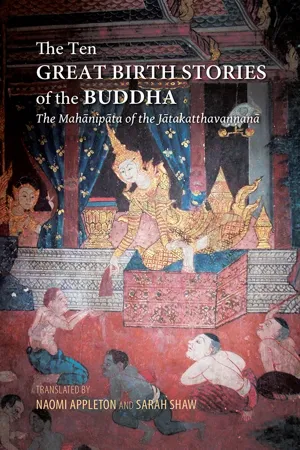
The Ten Great Birth Stories of the Buddha
The Birth Story of Temiya, or of the Dumb Cripple
- 32 pages
- English
- ePUB (mobile friendly)
- Available on iOS & Android
The Ten Great Birth Stories of the Buddha
The Birth Story of Temiya, or of the Dumb Cripple
About this book
Chapter: The Birth Story of Temiya, or of the Dumb Cripple This is the first complete English translation in over a century of the ten great j taka tales covering the Bodhisatta's final adventures in the human realm before his ultimate life and enlightenment as the Buddha. Introductory comments to each story provide background and analysis. A general introduction explores themes and the stories' role in Buddhist art and practice. Color images show the stories' centrality in the Buddhist visual landscape of Southeast Asia.These definitive new translations reestablish the stories as ancient literary treasures of South Asia. Readers will be delighted by their magic and intrigue, philosophical insight, and deep roots in the religious and cultural world of the Buddha.
Frequently asked questions
- Essential is ideal for learners and professionals who enjoy exploring a wide range of subjects. Access the Essential Library with 800,000+ trusted titles and best-sellers across business, personal growth, and the humanities. Includes unlimited reading time and Standard Read Aloud voice.
- Complete: Perfect for advanced learners and researchers needing full, unrestricted access. Unlock 1.4M+ books across hundreds of subjects, including academic and specialized titles. The Complete Plan also includes advanced features like Premium Read Aloud and Research Assistant.
Please note we cannot support devices running on iOS 13 and Android 7 or earlier. Learn more about using the app.
Information
| F | Fausbøll’s edition of the Jātakatthavaṇṇanā |
| J | Jātakatthavaṇṇanā stories by number, or volume and page as in the Cowell/Rouse translation |
| PED | Pāli-English Dictionary, ed. Rhys-Davids and Stede |
| VRI | Vipassana Research Institute electronic edition of the Pāli scriptures |
Temiya
The Silent Prince, for it is the first time that the prince makes a sound.1 The story then moves to the forest, a peaceful juxtaposition to the busy life of the city and a place in which real spiritual progress can be made.
Table of contents
- The Ten Great Birth Stories of the Buddha